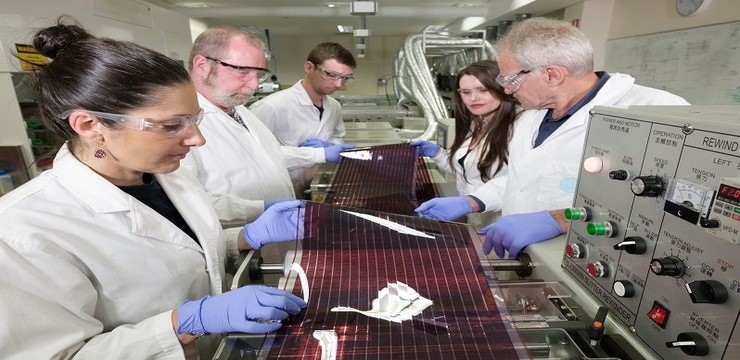This Australian Breakthrough Promises A New Era of Printed Solar Panels
Page Contents
Written by qualified solar engineer Aniket. Last updated:
A new technological breakthrough in Australia’s Newcastle University promises to usher in a new era for printed solar panels. The team, led by physics Professor Paul Dastoor, has succeeded in producing ultra-thin, flexible printed solar panels. These panels can be pasted on any surface to generate electricity.
For decades, traditional solar panels with bulky and rigid components have been the norm. Their rigid front glass and metal frame make the panels less versatile. They also require additional mounting structures made of metals, which increases the weight as well as cost of the systems. The new development may be the key to more versatile and cost-effective ways of harnessing solar energy, and thus in a more widespread manner.
Lighter, Cheaper, Simpler

Printed solar cells at an exhibition in Sydney (Source – University of Newcastle)
While conventional solar panels are primarily constructed from silicon, the flexible panels developed by this team are made from organic polymers. For many years, researchers have been trying to develop cheap, printable panels, but this might be one of the few successful results.
The production of these panels is remarkably simple. Liquid organic polymers are laid on top of sheets of materials. The best part is that this can be done using everyday printers, like printing a picture on paper. This creates a solar panel that is merely 0.075 mm thick, as compared to traditional solar panels which often reach up to 1.5 inches in thickness – this is truly groundbreaking.
There is also a huge difference in the weights – while regular solar panels weigh around 50 pounds, the printed solar panels in question are astonishingly light at just a few grams. Additionally, these panels can be pasted on nearly any surface using a special adhesive. This also eliminates the cost and weight involved in the mounting structures and ballasts.
Owing to all the above factors, the panels developed by Professor Dastoor and his team are inexpensive. They cost between $7 and $10 per square meter, which is quite low compared to the cost per surface area of regular solar panels.
Room for Improvement
Traditional solar panels might be bulky and costlier, but thanks to the huge amount of engineering and precision manufacturing work that goes into it, they have reached impressive efficiencies as well as lifespans.
The printed solar panels might have some advantages over traditional solar panels, but their biggest disadvantage is their low efficiency. Currently, while silicon-based solar panels work with efficiencies around 20%, the printed solar panels are yet not able to reach the 1% mark.

Production of printed solar panels (source – ABC News)
The research team, however, is confident that the technology will become more efficient in the coming years – efficient enough to be commercially viable.
Applications
Though the printed panels in question are not highly efficient, their remarkably low cost means it can make solar power accessible to everyone.
As per the researchers, in the near future, printed solar technology could be developed to fit almost any surface to power urban lighting, roadside water pumps, disaster shelters, caravans, camping equipment, etc.
Though the efficiencies aren’t exciting yet, Professor Dastoor envisions a different business model for the printed solar panels. Instead of purchasing the panels, he believes a better model for customers will be to buy a plan, like a mobile phone plan.
In such a case, the panel providers will charge the customers for electricity and paste panels all over their roof. The price will be lower than their existing bills, and every time a better version is developed, the company will swap the older version for the new one.
We hope you liked this article. Please rate it or leave us a comment.
Average rating 5 / 5. Vote count: 4
No votes so far! Be the first to rate this post.





